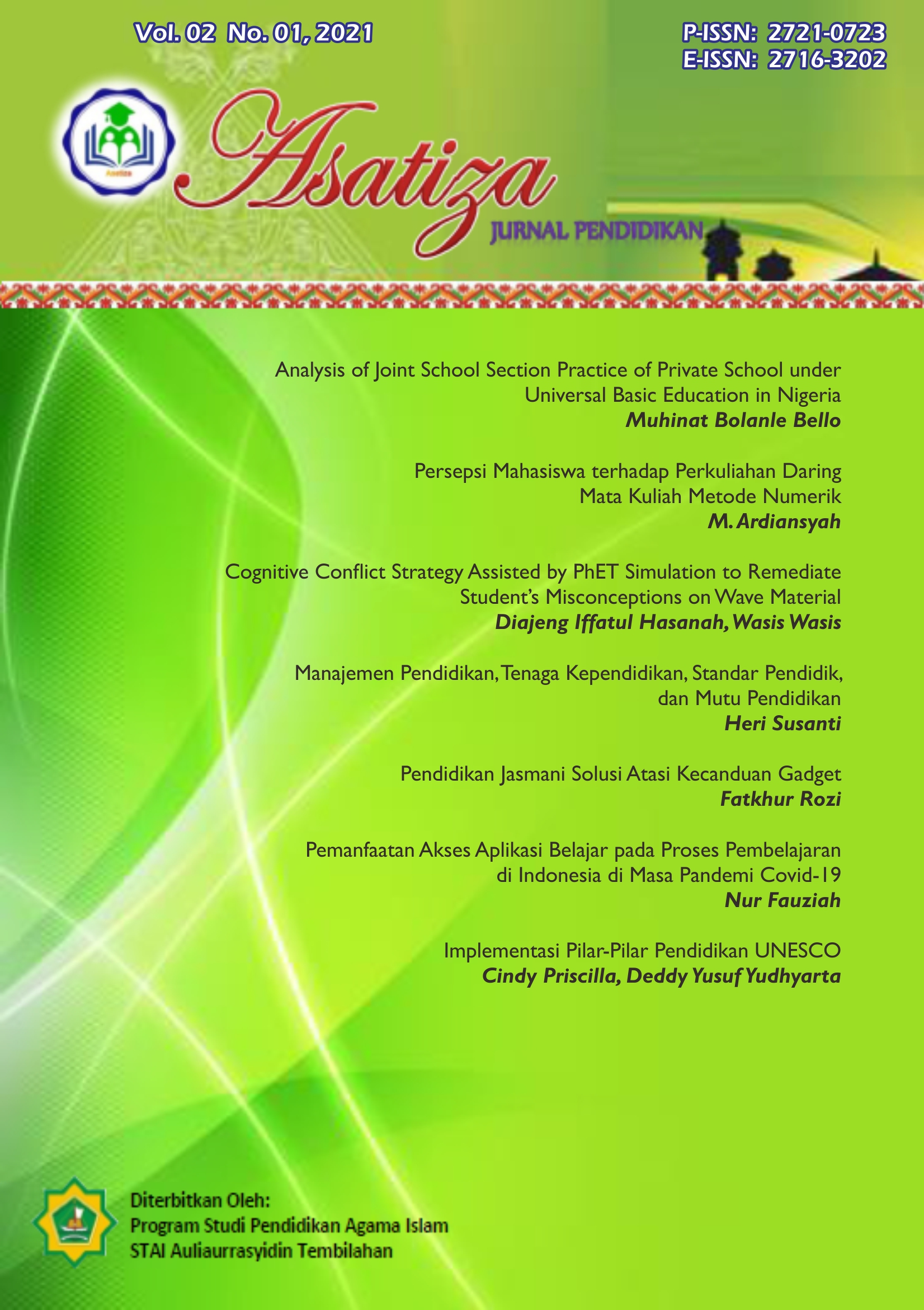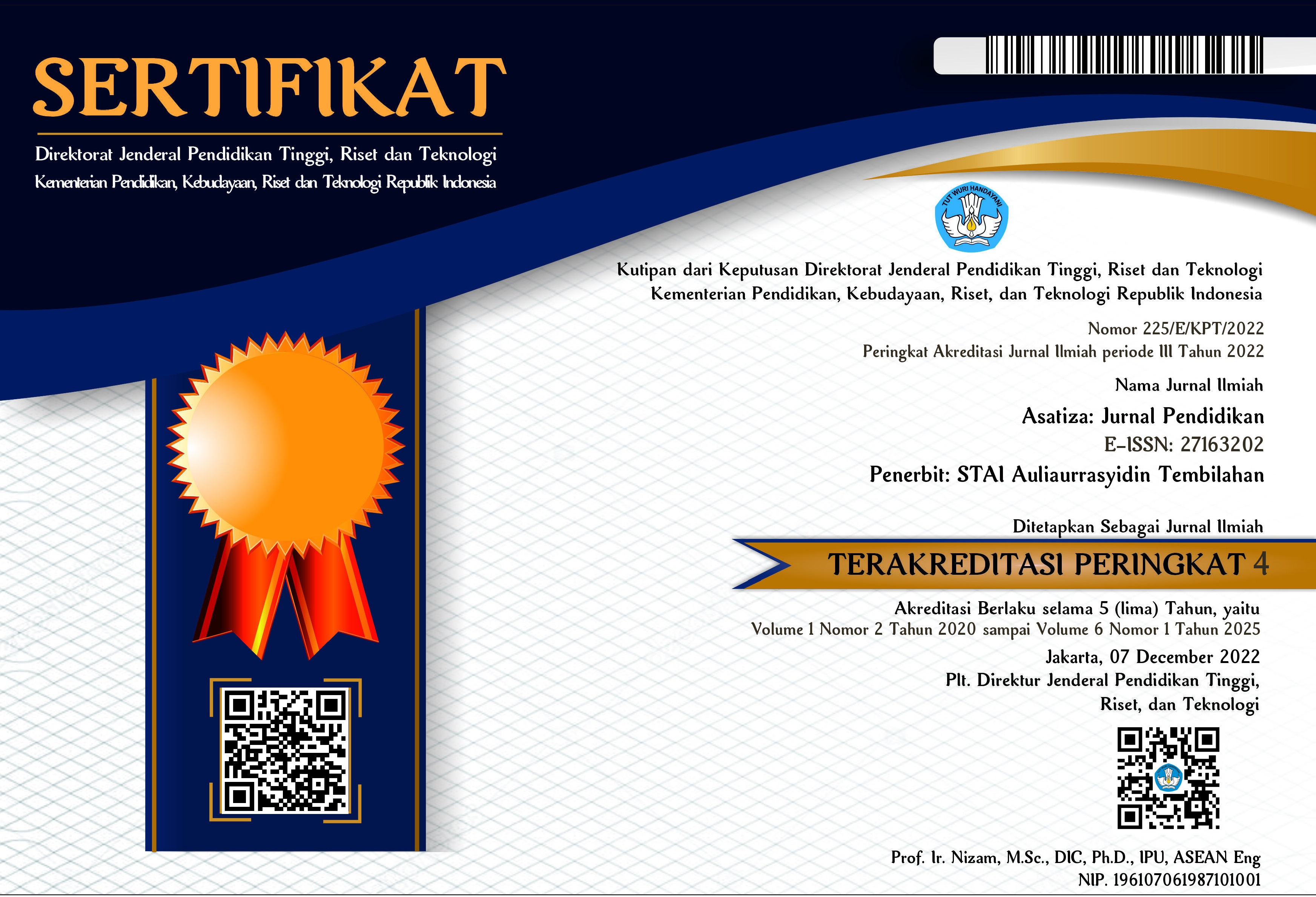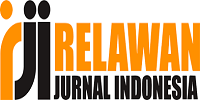Pendidikan Jasmani Solusi Atasi Kecanduan Gadget
DOI:
https://doi.org/10.46963/asatiza.v2i1.251Keywords:
Children, gadgets, physical educationAbstract
Gadgets are the technological developments created through sophisticated previous devices with more practical goals and functions. The development of gadgets provides convenience and effectiveness of the work that a person does. On the other hand, it also has a negative impact if use is not under control. The existence of gadgets is not only used by adults but also by adolescents and children. Uncontrolled and excessive use of gadgets can lead to addiction at the age of children and impact children's development, such as emotional and behavioral disorders, lack of movement that triggers health problems and triggers individualistic attitudes. This study aimed to solve gadget addiction through the implementation of good physical education in schools. This study was a qualitative study with a scientific review approach. The results provided an overview of the formation of good character, growth of social values that exist during physical education to prevent the younger generation being addicted to gadgets.
Downloads
References
Banat, A., & Martiani, M. (2020). Kemandirian belajar mahasiswa penjas menggunakan media google classroom melalui hybrid learning pada pembelajaran profesi pendidikan di masa pandemi covid-19. Jurnal Teknologi Pendidikan, 13(2), 119-125. https://doi.org/10.24114/jtp.v13i2.20147.
Delima, R., Arianti, N. K., & Pramudyawardani, B. (2015). Identifikasi kebutuhan pengguna untuk aplikasi permainan edukasi bagi anak usia 4 sampai 6 tahun. JuTISI (Jurnal Teknik Informatika Dan Sistem Informasi), 1(1), 40-47. https://doi.org/10.28932/jutisi.v1i1.569.
Engel, V. J. L. (2012). Upaya melindungi anak-anak dari fornografi di internet. Jurnal Sosioteknologi, 11(25), 60–65. http://journals.itb.ac.id/index.php/sostek/article/view/1089.
Gunawan, M. A. A. (2017). Hubungan durasi penggunaan gadget terhadap perkembangan sosial anak prasekolah di TK PGRI 33 Sumurboto, banyumanik. http://eprints.undip.ac.id/55141/.
Gustiawati, R., Fahrudin, F., Kurniawan, F., & Indah, E. P. (2019). Pengembangan pendekatan evaluasi the most significant change technique dalam pembelajaran pendidikan jasmani olahraga dan kesehatan. Multilateral: Jurnal Pendidikan Jasmani dan Olahraga, 18(2), 125–129. http://dx.doi.org/10.20527/multilateral.v18i2.7624.
Herlina, H., & Suherman, M. (2020). Potensi pembelajaran pendidikan jasmani olahraga dan kesehatan (PJOK) di Tengah pandemi corona virus disease (Covid)-19 di Sekolah Dasar. Tadulako. Journal Sport Sciences And Physical Education, 8(1), 1–7. http://jurnal.untad.ac.id/jurnal/index.php/PJKR/article/view/16186.
Mustafa, P. S., & Dwiyogo, W. D. (2020). Kurikulum pendidikan jasmani, olahraga, dan kesehatan di Indonesia Abad 21. JARTIKA: Jurnal Riset Teknologi dan Inovasi Pendidikan, 3(2), 422–438. https://doi.org/10.36765/jartika.v3i2.268
Nasirudin, N, & dkk. (2016). Modul guru Pembelajar. Jakarta: Kemendikbud.
Novitasari, W., & Khotimah, N. (2016). Dampak penggunaan gadget terhadap interksi sosial anak usia 5-6 tahun. PAUD Teratai, 5(3), 182–186. https://jurnalmahasiswa.unesa.ac.id/index.php/paud-teratai/article/view/17261.
Pambudi, M. I., Winarno, M. E., & Dwiyogo, W. D. (2019). Perencanaan dan pelaksanaan pembelajaran pendidikan jasmani olahraga kesehatan. Jurnal Pendidikan: Teori, Penelitian, & Pengembangan, 4(1), 110–116. http://dx.doi.org/10.17977/jptpp.v4i1.11906.
Paryanto, R., & Wati, I. D. P. (2013). Upaya meningkatkan kebugaran jasmani siswa melalui pendidikan jasmani. Jurnal Pendidikan dan Pembelajaran Khatulistiwa (JPPK), 2(5), 143–154. https://jurnal.untan.ac.id/index.php/jpdpb/article/view/1974/0.
Rozi, F., & Setyawati, H., Soekardi, S. (2017). Sosialisasi, Partisipasi, Interaksi Sosial, Gender, dan Norma Pada Perkembangan Sepak Takraw Jepara. Journal Of Physical Education And Sports, 6(3), 255–260. https://journal.unnes.ac.id/sju/index.php/jpes/article/view/14628
Rukmana, A. (2008). Pembelajaran Pendidikan Jasmani di Sekolah Dasar. Jurnal Pendidikan Dasar, 9.
Sari, P., & Mitsalia, A. A. (2016). Pengaruh penggunaan gadget terhadap personal sosial anak usia pra sekolah di TK IT Al Mukmin. PROFESI (Profesional Islam), 13(2), 73–77. http://dx.doi.org/10.26576/profesi.124
Simamora, A. S. M. T., Suntoro, I., & Nurmalisa, Y. (2016). Persepsi orangtua terhadap dampak penggunaan gadget pada anak usia pendidikan dasar. Jurnal Kultur Demokrasi, 5(6), 1–16. http://jurnal.fkip.unila.ac.id/index.php/JKD/article/view/11569
Surahni. (2017). Pendidikan jasmani, olahraga dan kesehatan (PJOK) sebagai sarana pendidikan moral. The 6th University Research Colloquium 2017, 41–46. http://journal.ummgl.ac.id/index.php/urecol/article/view/937.
Syahra, R. (2011). Informatika Sosial Peluang dan Tantangan. Jakarta: LIPI.
Utama, A. M. B. (2011). Pembentukan karakter anak melalui aktivitas bermain dalam pendidikan jasmani. Jurnal Pendidikan Jasmani Indonesia, 8(1), 1–9. https://doi.org/https://doi.org/10.21831/jpji.v8i1.3477.
Viandari, K. D, & Susilawati, K. P. A. (2019). Peran pola asuh orangtua dan penggunaan gadget terhadap interaksi sosial anak prasekolah. Jurnal Psikologi Udayana, 6(2), 76-87. https://doi.org/10.24843/JPU.2019.v06.i01.p08.
Widodo, B. (2017). Implementasi nilai nilai karakter siswa pada pembelajaran PJOK di Madrasah Ibtidaiyah Bintoro. Jurnal Pendidikan dan Pembelajaran Dasar, 9(2), 164–168. https://doi.org/10.18860/jt.v9i2.4794
Yuliawan, D. (2017). Pembentukan karakter anak dengan jiwa sportif melalui pendidikan jasmani olahraga dan kesehatan. Jurnal SPORTIF: Jurnal Penelitian Pembelajaran, 2(1), 101-112. https://doi.org/10.29407/js_unpgri.v2i1.661.
Downloads
Published
Issue
Section
License
Authors who publish with this journal agree to the following terms:
1. Copyright on any article is retained by the author(s).
2. The author grants the journal, right of first publication with the work simultaneously licensed under a Creative Commons Attribution shareAlike 4.0 International License that allows others to share the work with an acknowledgment of the work’s authorship and initial publication in this journal.
3. Authors are able to enter into separate, additional contractual arrangements for the non-exclusive distribution of the journal’s published version of the work (e.g., post it to an institutional repository or publish it in a book), with an acknowledgment of its initial publication in this journal.
4. Authors are permitted and encouraged to post their work online (e.g., in institutional repositories or on their website) prior to and during the submission process, as it can lead to productive exchanges, as well as earlier and greater citation of published work.
5. The article and any associated published material is distributed under the Creative Commons Attribution-ShareAlike 4.0 International License











2.png)



